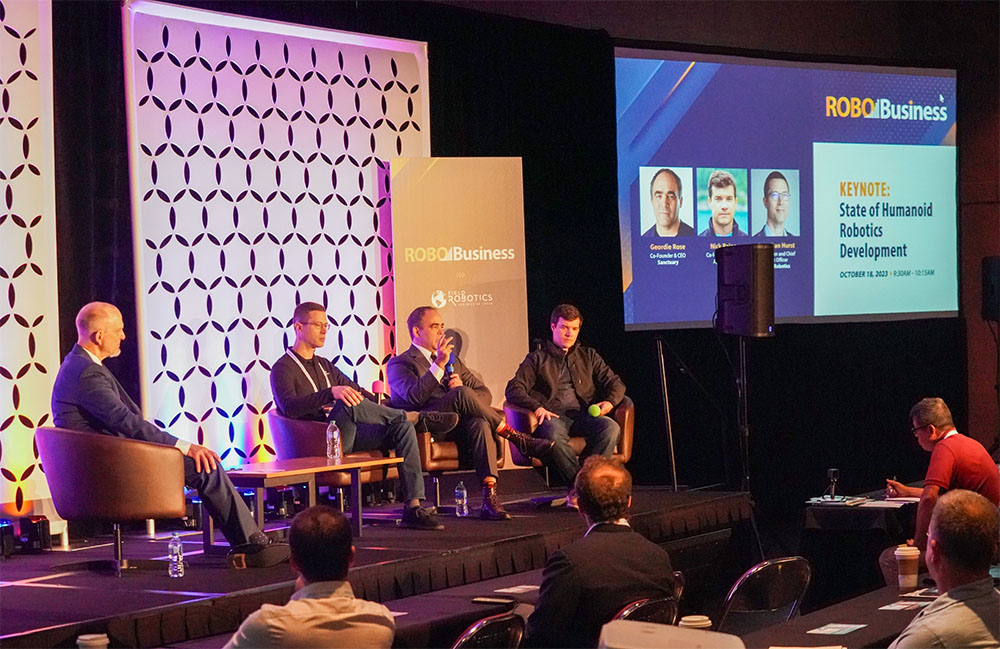The 5 biggest robotics industry trends of 2023
2023 has been full of exciting innovations within the robotics industry. We’ve seen the rise of new technologies, and robotics developers have pushed the boundaries of what robots can do.
At the same time, there has been a dip in robotics funding across the board, and some sectors have struggled to gain public trust.
As 2023 comes to an end, let’s look back at some of the biggest trends in the robotics industry this year.
Humanoid robots make strides
Were it not for ChatGPT – more on that later – humanoid robots would have been the biggest story in robotics, automation, and AI of 2023.
In January, Boston Dynamics posted YouTube videos of its Atlas robot running around a simulated construction site and throwing a bag of tools onto a scaffold.
Other humanoid robots emerging this year included Figure AI’s Figure 01, Sanctuary AI’s sixth-generation Phoenix, Unitree’s H1, and Apptronik’s Apollo. In September, Tesla showed its Optimus, which it originally announced in 2022, moving in new ways, and in December, it demonstrated Gen 2’s dexterity.
Companies raising money to continue developing humanoid robots included Apptronik’s unspecified investment from Terex in February and Figure AI’s $70 million Series A in May. China recently announced plans to mass produce humanoids by 2025 as part of its ongoing technological rivalry with the U.S.
While some companies, such as Sanctuary AI, claimed to be building “general-purpose” robots, most are starting with logistics applications. However, none are yet being used in production environments, and many technical challenges remain.
While it’s impressive that such systems can climb stairs and move around in spaces designed for humans, their size and weight require safety scrutiny. Standards organization ASTM International in May launched the F45.06 Subcommittee on Legged Robot Systems.
A keynote panel at RoboBusiness 2023 included founders of leading humanoid developers, including Apptronik’s Jeff Cardenas, Agility Robotics’ Jonathan Hurst, and Sanctuary’s Geordie Rose. They discussed design challenges and the evolution of robot dexterity.

RoboBusiness 2023 featured a keynote panel including representatives from three leading humanoid manufacturers. Seated left to right: Mike Oitzman (moderator); Jonathan Hurst Co-founder and Chief Robot Officer | Agility Robotics; Geordie Rose CoFounder & CEO | Sanctuary; Nick Paine Co-Founder and CTO | Apptronik
The most promising news about humanoid robotics came from Agility Robotics, which demonstrated its Digit moving totes at ProMat. In September, the company said it is building “RoboFab,” a factory in Salem, Ore., to produce up to 10,000 robots per year.
In October, the company announced that Amazon was conducting the first commercial testing of a humanoid robot.
Generative AI promises to change human-robot interaction
Recent advances in artificial intelligence dominated the news cycle for all of 2023, and not just in robotics circles. While OpenAI first introduced its Generative Pre-trained Transformer (GPT) in 2018, it wouldn’t reach wide use until GPT-3.5, which OpenAI released at the tail end of 2022.
GPT-3.5 gained 100 million users in just 2 months. At the beginning of the year, ChatGPT passed the final exam for the University of Pennsylvania’s Warton School’s Master of Business Administration (MBA) program.
After the success of GPT-3.5, a slew of other companies released their own generative AI programs. Microsoft introduced Kosmos-1 in February, OpenAI released the updated GPT-4 in March, and Google released Bard later that month.
These offerings have opened the door for the robotics industry to begin testing generative AI to unlock new capabilities.
Agility Robotics has experimented with using large language models (LLMs), which power tools like ChatGPT, to control Digit. It took the company only two weeks to create a demo of Digit following natural-language commands.
Microsoft has announced plans to build GPT-powered robots with Doosan Robotics and plans to use generative AI to develop robots with Rockwell Automation.
At RoboBusiness in October, we hosted a generative AI keynote panel. It featured:
- Pras Velagapudi, vice president of innovation at Agility Robotics
- Jeff Linnell, founder and CEO of Formant
- Ken Goldberg, the William S. Floyd Jr. Distinguished Chair in Engineering at UC Berkeley
- Amit Goel, director of product management at NVIDIA
- Ted Larson, CEO of OLogic
Next year has all the makings of another year of innovation when it comes to AI. Researchers, who have taught robots how to pick tomatoes or quickly learn new tasks using AI, said they have only scratched the surface of possibilities.
Picking and mobile robot providers mark milestones
While generative AI and humanoid robots garnered a lot of attention this year, traditional robotics applications have also advanced. Picking robots and mobile robots were still chugging along in 2023.
In August, Locus Robotics, a Wilmington, Mass.-based developer of autonomous mobile robots (AMRs), announced its robots have picked more than 2 billion units. The milestone came just 11 months after it picked its first billion units in 2022.
Locus also had a booming holiday season this year. Its robots picked 331 million units for its third-party logistics (3PL) partners, with about 7 million average daily picks.
When it comes to picking robots, manufacturers have pushed the robotics industry to make them more flexible and easier to install. This year, we’ve seen more and more robots that can handle variable-mix, variable-volume lines.
After years of work on grippers and machine vision, providers of picking systems, vendors such as Brightpick, Covariant, and Mecalux reported progress in 2023.
In addition, “no-code” systems, which can be installed without a robotics engineer on site, are becoming more common, were available from companies including ABB, Robust.AI, and Yaskawa.
Autonomous vehicles get yellow flags
Autonomous vehicles (AVs) have had a bumpy ride in 2023, and Cruise, the self-driving unit of GM, has been at the center of much of the controversy.
Weeks before 2023 began, Cruise had already started facing troubles. In December 2022, the National Highway Traffic Safety Administration (NHTSA) opened an investigation into Cruise’s automated driving system.
The NHTSA’s ongoing investigation focuses on two alleged problems with Cruise’s AVs. The first is that they might brake too hard when cars approach them from behind, resulting in potential hazards for other drivers. The NHTSA also expressed concern about the tendency for Cruise’s vehicles to become immobilized on the road.
Despite the investigation, Cruise attained 1 million driverless miles just 15 months after it gave its first ride. Throughout the year, the company expanded its San Francisco and Phoenix services, launched services in Houston, and announced plans to start services in Nashville; Charlotte, N.C.; and more.
In April, however, Cruise recalled 300 robotaxis in response to an accident in which its AV hit the back of a San Francisco bus.

A Cruise robotaxi failed to brake quickly enough behind a city bus in San Francisco. | Source: Cruise
A major milestone came in August, when the California Public Utilities Commission (CPUC) granted Cruise and Waymo their final permits. These permits allowed the companies to charge for all rides, expand hourly operations and service area, and add as many robotaxis to the companies’ fleets as they want.
The California DMV suspended Cruise’s final permit a little over two months later. California officials claimed that Cruise didn’t show regulators all of its footage from an Oct. 2 incident. During that incident, a Cruise robotaxi dragged a woman after she was hit by a different car driven by a human.
After being hit by the first car, the woman was thrown into the path of the Cruise vehicle, which couldn’t brake in time to avoid her. Cruise disputed claims that it withheld footage or information from the DMV, but it paused all of its operations nationwide to reestablish trust with the public.
Since the California DMV suspended its permits, Cruise has been on a bit of a downward spiral. In November, Cruise also laid off contractor workers who were responsible for cleaning, charging, and maintaining vehicles.
Later last month, Cruise co-founder and CEO Kyle Vogt and co-founder Dan Kan resigned. Mo Elshenawy, Cruise’s former executive vice president of engineering, took over as president and chief technology officer.
More recently, Cruise laid off 900 employees, 24% of its workforce.
Cruise hasn’t been the only AV company to struggle this year. In February, Tesla issued a voluntary safety recall at the request of the NHTSA after the agency determined that the company’s advanced driver assistance feature, Tesla’s Full Self-Driving (FSD) beta software, could create a “crash risk.”
The recall affected almost 363,000 Tesla vehicles equipped with FSD. Earlier this month, it recalled more than 2 million vehicles as the NHTSA continues to investigate safety issues with its Autopilot system.
These incidents have left the public and regulators wary of the AV industry as a whole. While Waymo still maintains its permits from the CPUC, and other companies like Zoox have begun testing their robotaxis on public streets, it’ll take time to win back public trust.
 Submit your nominations for innovation awards in the 2024 RBR50 awards.
Submit your nominations for innovation awards in the 2024 RBR50 awards.
Robotics industry sees sales dip after record years
In 2022, North American robot sales hit a record high, according to the Association for Advancing Automation (A3). It beat out 2021, which also set a record.
The robotics industry began to slow down at the end of 2022, as much of the record breaking sales happened in the first nine months of last year. This decline carried over into 2023.
2023 started slow, with first-quarter sales dipping 21% from the same quarter in 2022. This continued throughout the year, as sales in Q2 were down 37% from the year before. Altogether, the U.S. robotics market was down 29% in the first half of the year.
The post The 5 biggest robotics industry trends of 2023 appeared first on The Robot Report.
from The Robot Report - Robotics News, Analysis & Research https://ift.tt/DrCQZOd
via artificialconference
Comments
Post a Comment